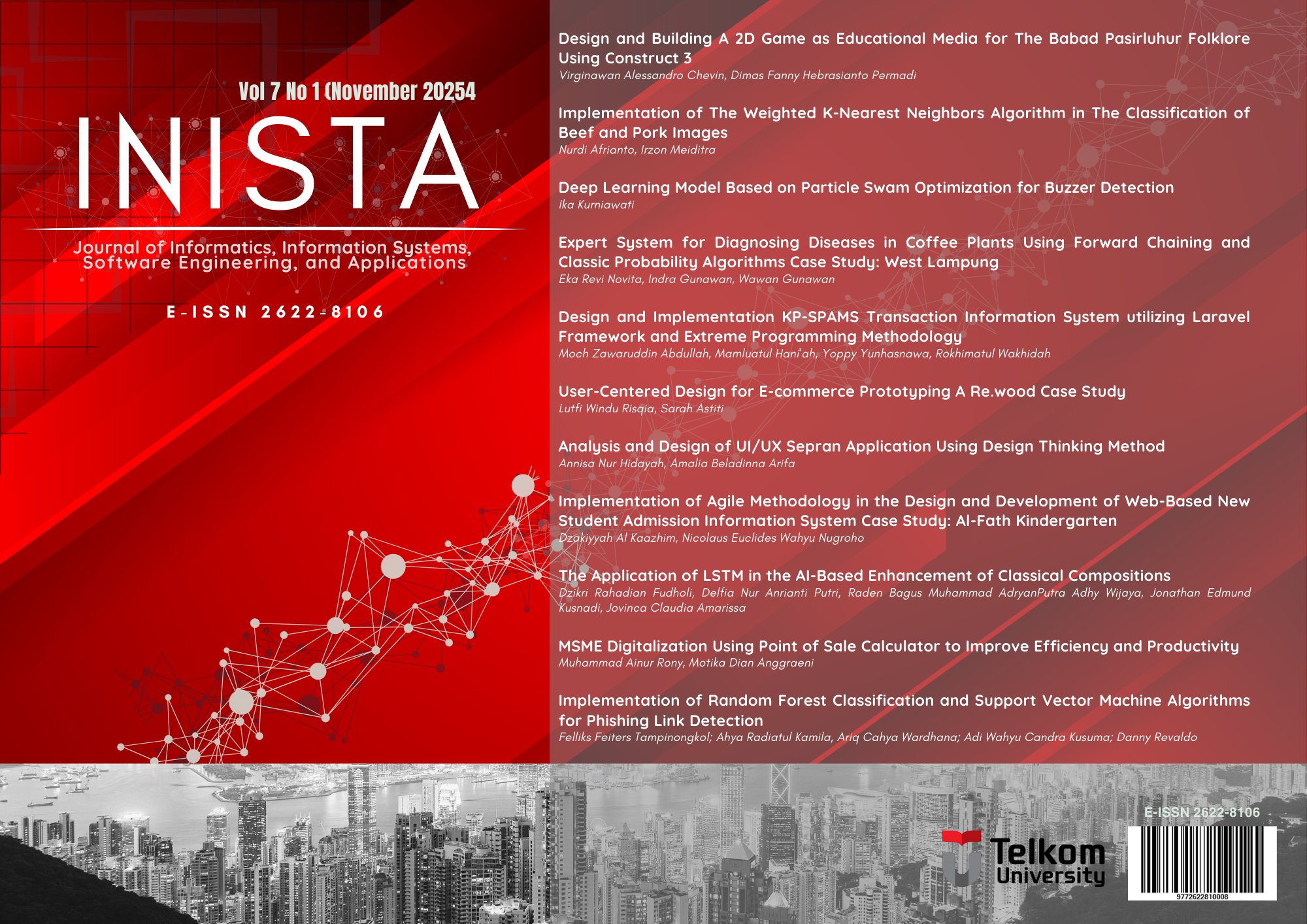Expert System for Diagnosing Diseases in Coffee Plants Using Forward Chaining and Classic Probability Algorithms Case Study: West Lampung
Main Article Content
Abstract
Coffee is a highly demanded product and a key commodity in Indonesia due to its significant market value and contribution to the country's foreign exchange. The majority of coffee plantations are found in highland areas, particularly in West Lampung Regency, which produced approximately 56,054 tons of coffee in 2022. However, coffee production has been declining due to low productivity and quality. One major issue is the limited knowledge of coffee farmers in West Lampung about diseases affecting coffee plants, leading to improper treatment. Another challenge is the lack of experts to guide farmers in managing and treating coffee diseases effectively. To address these problems, an expert system is needed to provide information and solutions for dealing with coffee diseases. This system incorporates expert knowledge into a computerized platform to assist in diagnosing coffee plant diseases. The system is developed using the waterfall method and employs forward chaining and classic probability algorithms to diagnose diseases and calculate the accuracy of results. Users can diagnose based on symptoms and receive treatment recommendations. This web-based expert system aims to assist farmers in early disease diagnosis and provide appropriate solutions for managing coffee diseases
Article Details

This work is licensed under a Creative Commons Attribution-ShareAlike 4.0 International License.
Authors who publish with this journal agree to the following terms:
- Authors retain copyright and grant the journal right of first publication with the work simultaneously licensed under a Creative Commons Attribution License (CC BY-SA 4.0) that allows others to share the work with an acknowledgement of the work's authorship and initial publication in this journal.
- Authors are able to enter into separate, additional contractual arrangements for the non-exclusive distribution of the journal's published version of the work (e.g., post it to an institutional repository or publish it in a book), with an acknowledgement of its initial publication in this journal.
- Authors are permitted and encouraged to post their work online (e.g., in institutional repositories or on their website) prior to and during the submission process, as it can lead to productive exchanges, as well as earlier and greater citation of published work.
References
[2] “Badan Pusat Statistik Provinsi Lampung.” https://lampung.bps.go.id/indicator/54/258/1/produksi-tanaman.html (accessed Mar. 04, 2024).
[3] N. J. Nilsson, “Artificial Intelligence_ A New Synthesis.” 2014.
[4] M. Naca Anbi, G. Fitri Laxmi, F. Riana, C. Hermanto, and B. Pengkajian Teknologi Pertanian Jawa Timur, “Sistem Pakar Diagnosis Penyakit dan Hama Tanaman Pisang dengan Metode Classical Probability,” Krea-TIF J. Tek. Inform., vol. 10, no. 1, pp. 51–58, 2022, doi: 10.32832/krea-tif.v10i1.6993.
[5] P. N. Stuart J. Russel, “Artifical Intelligence A Modern Approach (fourth edition),” Angew. Chemie Int. Ed. 6(11), 951–952., 2021.
[6] M. K. B.herawan hayadi,S.Kom, Sistem pakar. riau: deepublish, 2018.
[7] K. D. P. Novianti, I. M. D. K. Gunawan, and N. K. Sukerti, “Implementasi Forward Chaining Untuk Mendiagnosis Penyakit Tanaman Kopi,” Inser. Inf. Syst. Emerg. Technol. J., vol. 1, no. 2, p. 88, 2021, doi: 10.23887/insert.v1i2.30547.
[8] Z. Azmi and V. Yasin, Pengantar Sistem Pakar Dan Metode. Medan: mitra wacana media, 2017.
[9] usti fatimah puji sari ramadhan, Mengenal metode sistem pakar. medan: uwais inspirasi indonesia, 2018.
[10] muhammad rizwan, Budidaya kopi. sumatera utara: cv. azka pustaka, 2021.
[11] loekas soesanto, Kompendium penyakit-penyakit kopi. yogyakarta: lily publisher, 2020.
[12] A. Abdul Wahid, “Analisis Metode Waterfall Untuk Pengembangan Sistem Informasi,” J. Ilmu-ilmu Inform. dan Manaj. STMIK, no. November, pp. 1–5, 2020.
[13] prihandoko monsya juansen, rg guntur alam, Pengujian dan implementasi sistem informasi. bengkulu: deepublish digital, 2024.
[14] P. . Roger S. Pressman, Software Engineering A PRACTITIONER’S APPROACH, 5th ed. Thomas Casson, 2001.
[15] M. Legita, teknik budidaya tanaman kopi. jogjakarta: trans idea publising.
